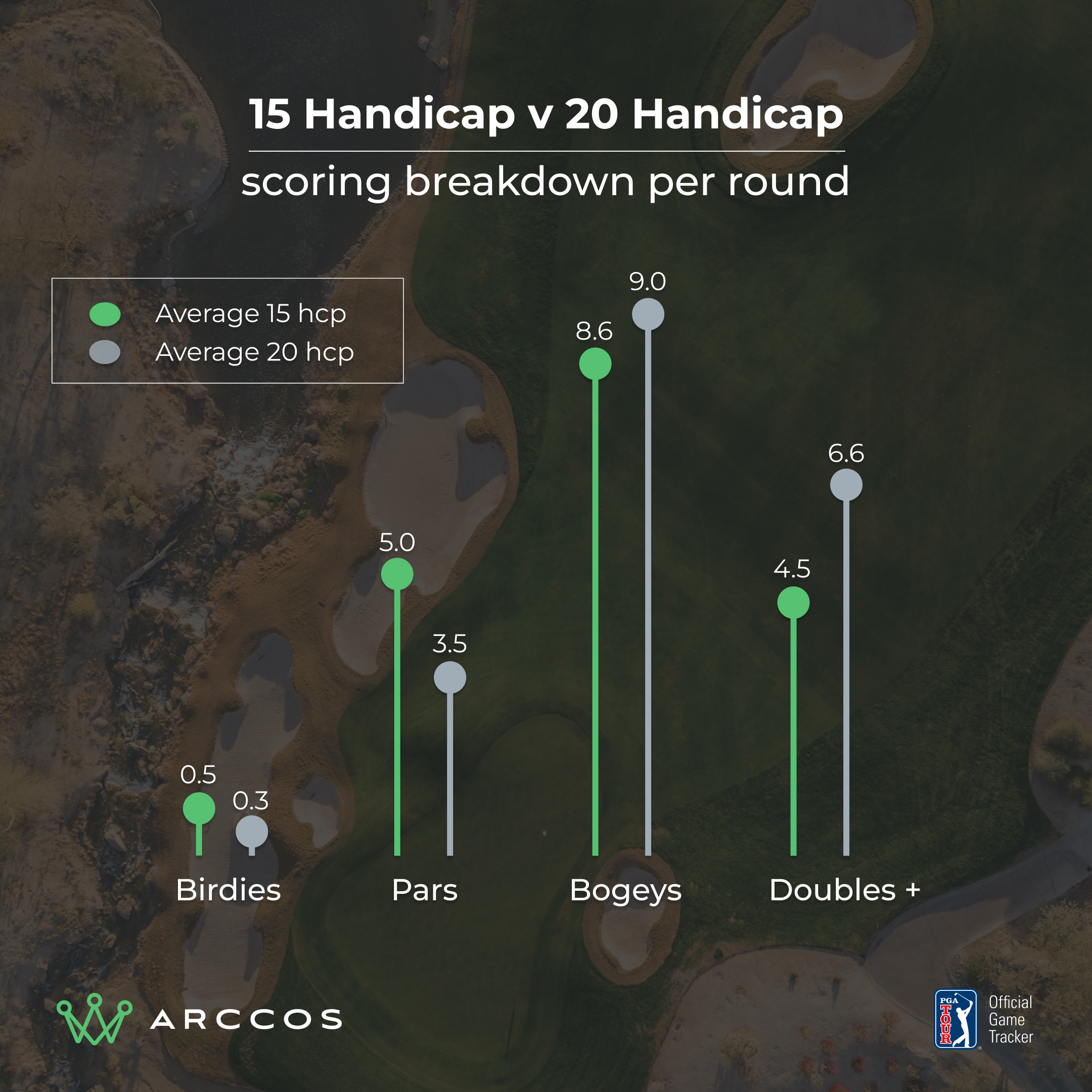Want To Save 5 Shots A Round? New Data Reveals The Key Differences Between 15- And 20-Handicappers
The difference between a 15- and 20-handicapper is much more nuanced than the obvious five shots...


Golf is a game of fine margins, and that is certainly the case when trying to improve your handicap. Many of us will have been in a situation where we feel stuck on a certain number, and aren't getting any better, so we start to wonder what we can do differently to get closer to our target.
Thanks to the latest data from Arccos, we can now reveal the main differences between a 15- and 20-handicapper, which you can use to fast-track your progress...
The main differences between a 15 and 20-handicapper
First of all, let's swiftly move past the obvious. Before I receive the 'very original' comment about the skill difference between a 15- and 20-handicapper being 5 shots, this data is designed to go much deeper into the nuances of where you need to improve your game to get to that lower number.
For starters, the dispersion isn't equal across the key facets of the game (Driving, approach, short game and putting). In fact, one of the crucial differences lies within the long game, with driving and approach play accounting for two thirds. That suggests that your quick wins could be powering up your golf swing or improving your ball-striking.
To go into a bit more detail on this, around 38 percent of the five-shot difference comes from approach play, and 26 percent from driving, while short game covers a much smaller portion (16%).
The difference in terms of putting between the two players is around 1 stroke per round on average, or 20 percent of the five shots, which is almost half of the premium placed on approach play.

Table showing where the five shot difference comes from in relation to the different areas of the game
There is also a clear contrast in scoring for each player, with the number of double bogeys or worse made being the biggest factor. A 20-handicapper (6.6) makes just over 2 more double-bogeys or worse than a 15-handicapper (4.5) on average per round, whereas there is just a 0.2 shot difference between the number of birdies made (0.3 vs 0.5). This clearly suggests that reducing the big scores is far more valuable than relying on a flurry of birdies.
Get the Golf Monthly Newsletter
Subscribe to the Golf Monthly newsletter to stay up to date with all the latest tour news, equipment news, reviews, head-to-heads and buyer’s guides from our team of experienced experts.
Interested in discovering insights on your own game from Golf Monthly's data partner? Check out the Arccos website and use code: 'GolfMonthly' to save 15%
The emphasis on approach play becomes clearer when you look at the number of greens in regulation made in the average round. A player with a 20-handicap finds just 3.6 greens per round, while someone with a 15-handicap performs slightly better with 4.9.
While it's great to say you have hit the green in regulation, proximity will also always be an indicator of scoring performance. The difference in proximity between the two ability levels is around 3 feet, with a 15-handicapper leaving themselves around 33 feet to the hole in comparison to the 36 feet left by a 20-handicapper.

15-handicap golfers hit the ball 3ft closer to the pin on average
So, what do I need to do to improve?
There are many ways to shave five shots off your handicap. The data above is for the 'typical' golfer, so while one 20-handicapper could putt much better than another, they may have a much weaker short game.
The two key takeaways are to focus on improving your driving and approach play, whenever you head to the range for 30 minutes, and eliminate double bogeys from your card. Tracking your stats while playing will also help you to gain a better understanding of your game, and indicate the specific areas that you need to work on.

Barry joined Golf Monthly in January 2024, and now leads the instruction section across all platforms including print and digital. Working closely with Golf Monthly's Top 50 Coaches, he aims to curate and share useful tips on every aspect of the game - helping amateurs of all abilities to play better golf. A member at Sand Moor Golf Club in Leeds, he looks forward to getting out on the course at least once a week in the pursuit of a respectable handicap.
Barry is currently playing:
Driver: Benross Delta XT Driver
Hybrid: TaylorMade Stealth 4 Hybrid
Irons: Benross Delta XT 5-PW
Wedges: TaylorMade RAC 60, Callaway Jaws MD5 54
Putter: TaylorMade Spider Tour
-
 'This One Is Just As Much His As It Is Mine' - Rory McIlroy Pays Emotional Tribute To 'Big Brother' Harry Diamond After Historic Masters Win
'This One Is Just As Much His As It Is Mine' - Rory McIlroy Pays Emotional Tribute To 'Big Brother' Harry Diamond After Historic Masters WinThe 2025 Masters champion couldn't hold back the tears when discussing the importance of his relationship with caddie Harry Diamond
By Elliott Heath Published
-
 Rory 2.0 Was Born At The 2025 Masters... McIlroy Is Now Free Of His 11-Year Major Burden
Rory 2.0 Was Born At The 2025 Masters... McIlroy Is Now Free Of His 11-Year Major BurdenThe Northern Irishman dug deeper than he ever had to get over the line and finally seal the missing green jacket to his career grand slam puzzle
By Elliott Heath Published
-
 Does A 15-Handicap 30-Year-Old Hit The Golf Ball Further Than A Scratch 50-Year-Old?
Does A 15-Handicap 30-Year-Old Hit The Golf Ball Further Than A Scratch 50-Year-Old?The influence that driving distance has on a player's handicap index is well documented, but how much does age impact the long game battle between two golfers?
By Barry Plummer Published
-
 Data Reveals This Once Popular Club Is Dying Out... But What Are Amateurs Opting For Instead?
Data Reveals This Once Popular Club Is Dying Out... But What Are Amateurs Opting For Instead?There have been plenty of moments in golf's history where the game has subtly shifted in a different direction, and we could be witnessing one right now...
By Barry Plummer Published
-
 Less than 10% Of All Tee Shots Are Hit With This Club... Is It Time For A Change Of Strategy?
Less than 10% Of All Tee Shots Are Hit With This Club... Is It Time For A Change Of Strategy?Plenty of amateur golfers step onto the tee box and instinctively pull the driver headcover, but it could be time for a data-informed change of strategy...
By Barry Plummer Published
-
 Amateur Golfers Make Less Than 40 Percent Of Putts From This Crucial Length'... Arccos Data Reveals Stark Putting Truths
Amateur Golfers Make Less Than 40 Percent Of Putts From This Crucial Length'... Arccos Data Reveals Stark Putting TruthsWhen standing over a 'makeable' putt, many golfers would fancy their chances as they pull the putter head back... But this data might make them think twice!
By Barry Plummer Published
-
 Fresh Data Shows The Age Amateur Golfers Hit Their Longest Drives... Is This True For You?
Fresh Data Shows The Age Amateur Golfers Hit Their Longest Drives... Is This True For You?Driving distance isn't everything, but data suggests longer tee shots can lead to a lower handicap. So, at what age do amateur golfers hit their longest drives?
By Barry Plummer Published
-
 Heading To The 1st Tee? Stop Right There! This Data Proves Why The Range Might Be A Better Choice...
Heading To The 1st Tee? Stop Right There! This Data Proves Why The Range Might Be A Better Choice...Getting better at golf requires more than just playing regularly on the course, with the data suggesting that practise time could be the key to success...
By Carly Frost Published
-
 Is It Better To Miss The Green In The Bunker Or Rough? The Data Is Clear Cut...
Is It Better To Miss The Green In The Bunker Or Rough? The Data Is Clear Cut...When assessing options for your next approach shot, this data will help you make better decisions on the 'good' miss and reduce the risk of bringing bogey into play
By Barry Plummer Published
-
 Why You DON'T Need To Make More Birdies To Chop 5 Shots Off Your Handicap
Why You DON'T Need To Make More Birdies To Chop 5 Shots Off Your HandicapFor a mid-handicap golfer, the route towards shooting lower scores and improving your handicap index is clear... if you have access to the right data!
By Barry Plummer Published
